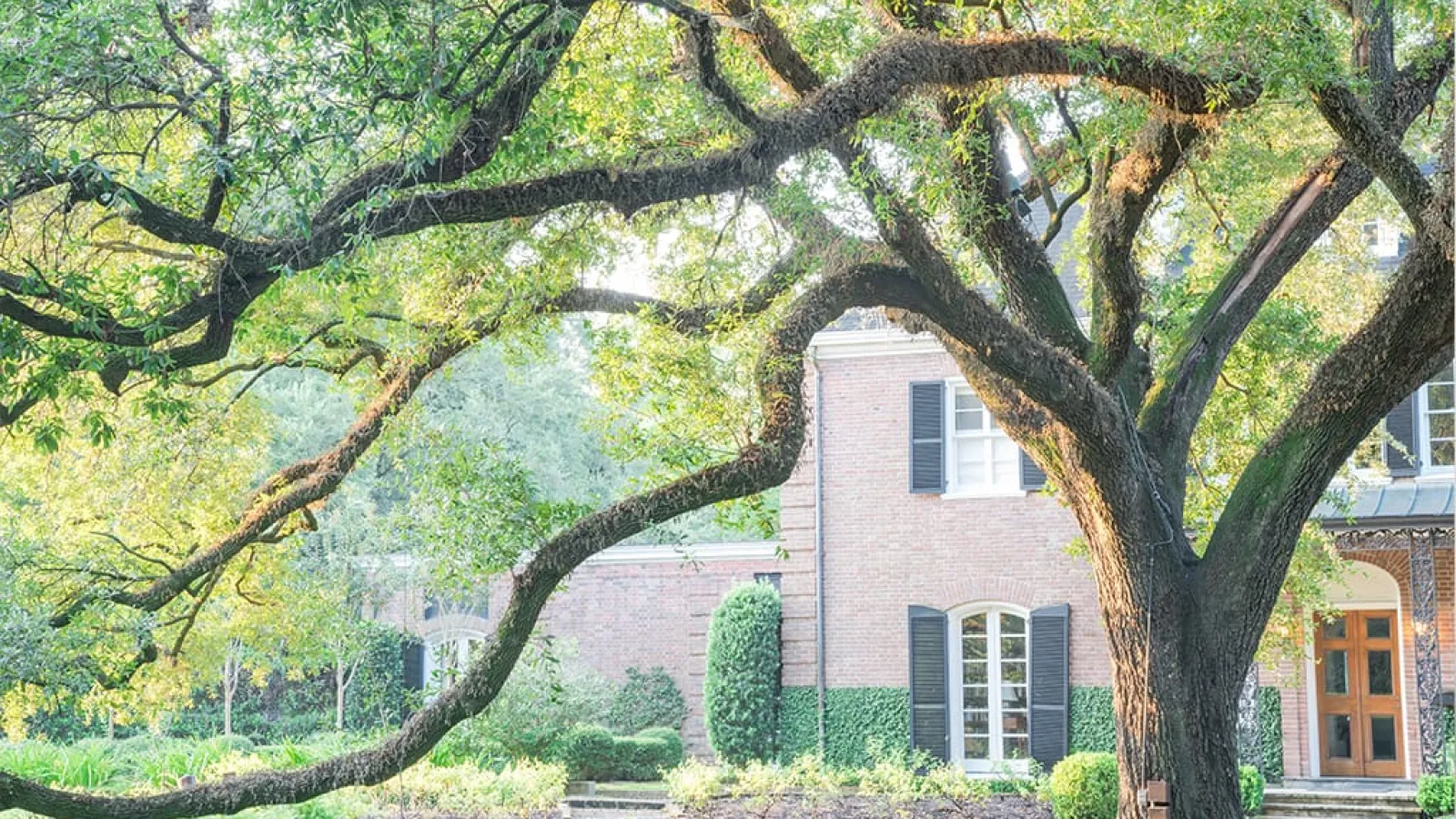As Georgia homeowners spend the warmer days maintaining and beautifying their properties, we encourage you to give consideration to energy-efficient landscaping techniques. Trees, shrubs and other plants are valuable not just for curb appeal, but to reduce the amount of cooling energy the home consumes, which generates cost savings for homeowners. Learn where to focus efforts when you landscape to improve energy efficiency to keep your home more comfortable – the natural way!
Use Trees When Landscaping for Energy Efficiency
Trees provide the most shade for your home, helping it stay cooler with less energy consumption by the air conditioner. While it takes time for trees to mature to offer maximum benefit, planting trees is a long-term project that pays off in the end, while offering some energy savings as they grow!
In a temperate region such as Atlanta, landscaping should take a focus on maximizing shade and directing breezes to the home to generate summer energy savings.
Trees provide shade to the home and limit solar heat gain. With effective planning, energy-efficient landscaping creates up to 50 percent savings on cooling costs when you add proper shade to your previously unshaded home!
Tree planting
Deciduous trees of 6 to 8 feet offer shading for windows within their first year of planting, helping reduce energy costs from the start. Many other species mature enough to start shading roofs within 5 to 10 years of planting. Deciduous trees planted on a home’s south side allow summer breezes to reach the house while shielding it from 70 to 90 percent of the summer sun. For more shade in the afternoon, use trees with lower crowns planted along the west side of the house.
When planting trees, it’s best to keep them away from your HVAC unit so root intrusion won’t cause damage.
Choose drought-tolerant trees because their branches will tolerate hot, dry air in the summer. Some examples of these types of trees include:
- American Elms
- Thornless Honey Locusts
- Red Maples
- Ginkgo Biloba
- Shagbark Hickory
- Texas Redbud
- Green Ash
Create a Windbreak
In addition to shading the home, planting trees can also help you control the ways wind impacts your home. A well-designed wind break created from planted trees produces an insulating space around the home to protect against wind chill. During the summer season, this arrangement helps direct summer breezes in the direction of the home.
- Evergreens planted on the north and northwest sides of a home create a barrier against cold winter winds.
- Adding a fence with evergreen trees provides greater deflection of cold winds to protect the home.
- Trees planted on either side of the house work can direct cool breezes to the structure during the summer months.
Shrub Selection
Shrubs offer dense greenery to hide your outdoor unit and still provide shade during the hot months. When energy-efficient landscaping, airflow is an important concern – you do not want to plant too close to the air conditioning unit because your shrubs will inhibit the system’s airflow.
When you decide which shrubs you want, plant them at least 2 to 3 feet away from the outdoor unit. The measurement should be from the tips of the branches to the air conditioning system. When planting young plants, you won’t know how long their branches will reach, so plant them farther away from your unit to anticipate potential branch growth.
As you begin landscaping to improve your home’s overall energy efficiency, shrubs can be used to limit the effects of heat radiation in certain surfaces surrounding your home. Pavement radiates a great deal of heat, which warms the air that moves toward your home’s structure. Planting a row of shrubs along the driveway, sidewalk or patio reduces heat radiation from pavement to keep the home cooler.
Your air conditioning unit blows out hot air while cooling your home, and the heat it sheds kills heat-sensitive shrubs. Avoid berry-producing shrubs; they create a mess around your outdoor unit. Also, avoid invasive species. Ideal options for shrubbery in your yard include:
- Jerusalem Sage
- Golden Currant
- Redberry
- Forsythia
- Sandankwa Viburnum
- Bluestem Joint Fir
- Cape Leadwort
- Candelilla
- Esperanza
Plant Planning
Beyond trees and shrubs, other plants can be used to further shade your home. Planting groundcover plants provides shade for pavement and the ground surrounding the home. With these plants in place, heat radiation is limited, so air is cooler before it comes into contact with the home’s structure.
Ivy and other climbing vines create shade for patios. Some good options include:
- Bougainvillea
- Trumpet Vine
- Jasmine
- Clematis
- Butterfly Vine
- Morning Glory
Landscaping Mistakes to Avoid
Before you begin landscaping your property, it’s important to know what not to do. These landscaping mistakes lower the energy efficiency of your AC system and have the potential to cause damage to the equipment.
Planting Too Close
The biggest mistake you can make when landscaping for energy efficiency is planting vegetation, including trees and shrubs, too close to your AC unit. If you plant shrubs and herbaceous plants too close, the HVAC vents can’t move air properly. You will also experience more leaves, twigs and weeds blocking your unit, resulting in overheating.
Install gravel around the unit instead of mulch or grass, which can stick up against the air conditioner’s fins and reduce airflow. If you choose grass, mow when the unit isn’t running so clippings aren’t sucked into the fins. Clean the exterior unit on a regular basis to reduce excess debris obstructing or damaging the fins.
Planting too close to the home’s structure can also create problems. When shrubs grow against the home’s walls and windows, wetness and humidity issues result. Make sure to space your planting to prevent too much density. Keep at least 1 foot of space between plants of mature size and the walls and windows of the home.
Leaving Debris Behind
Landscaping generates some debris, and it’s normal to deal with minor twigs, clippings or leaves cluttering the area around your AC unit. What isn’t normal or healthy is uncontrolled branches, sticks and other debris compromising your air conditioner. During storms or high winds, debris has the potential to cause damage to your unit.
Incorporate air conditioner maintenance into your landscaping plans this season. Trim back any shrubs or plants growing within a few feet of it. This keeps your unit accessible to technicians and allows adequate airflow around all sides.
When landscaping or performing regular maintenance jobs, make sure to bag up and properly dispose of all natural debris. Stay on top of pruning and removal of dead limbs for shrubs and trees in the areas around your air conditioner to prevent the possibility of them falling on and damaging your unit.
If you have a strong thunderstorm, make a point to walk around the unit to check it for damage or excessive debris. Contact Estes Service for preventative maintenance, which includes cleaning vents, air ducts and the components in your outdoor AC unit.
Improve Energy Efficiency with Estes Services
Energy-efficient landscaping, when done the right way, helps keep your home more comfortable with less energy consumption. Is your air conditioner operating as efficiently as it could be? Make sure annual maintenance is always performed, and performance issues are repaired right away to limit excessive energy consumption. Contact Estes Services today to schedule service.


